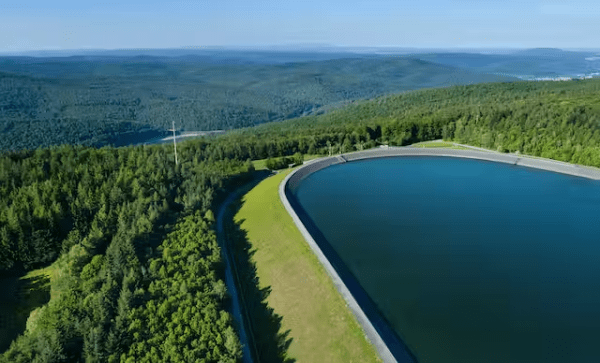A pumped-storage hydroelectricity (PSH) facility moves water into a high-level reservoir during times of low demand, and then generates electricity by releasing water during times of high demand. Most storage occurs at night and most electricity is generated during the day. PSH is a proven method of energy storage with competitive round-trip efficiency and long life spans.
To rely more on intermittent wind and solar power, energy storage is needed. British Columbia already has a number of reservoirs providing holding energy, but as wide spread electrification proceeds, additional capacity will be needed until improved battery systems evolve.
A U.S. Department of Energy report (see below) used geographic information system analysis of potential new closed-loop pumped PSH systems and found “potential for 35 terawatt-hours (TWh) of energy storage across 14,846 sites, which represents 3.5 terawatts (TW) of capacity when assuming a 10-hour storage duration.”
Areas with the greatest potential and the lowest-cost sites are in regions with higher elevation differences, leading to a significant concentration of potential in western North America. Places in Canada like British Columbia and Alberta. Perhaps not the latter, unless the oil industry decides their government should end its pause on clean renewable energy.
The Canyon Creek Project, first of its kind in Western Canada, will have initial generating capacity of 75 megawatts (MW) (expandable through future development to 400 MW) and utilizes existing site infrastructure from a decommissioned open pit coal mine.

While battery innovations get a lot of attention, there’s a simple, proven long-term storage technique that’s been used in the U.S. since the 1920s. It’s called pumped hydro energy storage.
The Conversation



Categories: Energy, Power Generation





Pumped-storage hydroelectric is a mature and useful technology, to backup intermittent renewables and meet demand spikes. There’s an impressive system in Wales in the UK, Dinorwig Power Station, which I’ve visited a couple of times. The generator hall was built inside a mountain, to reduce the impact on the Snowdonia national park, although the surrounding disused slate mine is not exactly pretty.
The Brits have a scenario called a ‘TV pickup’ when millions of people turn on their 3 kW electric kettles at the same time to make tea during advert breaks and at the end of TV shows, instantly adding several 100 MWs to demand, and sometimes as much as a few GW. Dinorwig can go from 0 MW to 1800 MW load in 16 seconds (when the generators are already spinning in air), and run for six hours at full flow, per Wikipedia.
LikeLike
In an age where the urgent need for sustainable and carbon-free energy solutions has never been greater, the Canyon Creek Project in Western Canada emerges as a promising beacon of hope. As the first of its kind in the region, this groundbreaking initiative harnesses the power of pumped-storage hydroelectricity (PSH) to pave the way for a greener and more sustainable future.
LikeLike
I love the chart at the end of your article. Who would have thought that Alberta would be putting BC to shame, on building clean, efficient, timely, cost-conscious power facilities?
(Writing this from your old home town of Powell River, Norm. On our way to the Island.)
LikeLiked by 1 person
Let’s hope it isn’t affected by Alberta’s new pause on renewable energy projects.
I wonder if there has ever been a Canadian government so captured by the oil and gas industry.
By the way, I talked last year with a couple who had been in the international luxury cruise ship business. They said the ferries on the circle trip — Horseshoe Bay-Sechelt Peninsula-Powell River-Comox-Vancouver — provided one of the nicest trips anywhere. Their favourite was the Earl Cove-Saltery Bay ferry that gets you close to Powell River. I’ve probably done that one hundreds of time, so my favourite is the crossing from Powell River to Comox.
LikeLike
It was our first-ever trip to Powell River (and Lund), in beautiful weather. ‘Hard to imagine ever getting used to the beauty of the area… but we are spoiled in BC.
Regarding the Alberta pause, I would hope that someone will point out the backlog of orphaned oil and gas wells that have left taxpayers on the hook for cleanup.
The government says they are worried about orphaned wind and solar installations — which is prudent — but at least they wouldn’t be dealing with spoiled soil and toxic waste.
LikeLiked by 1 person